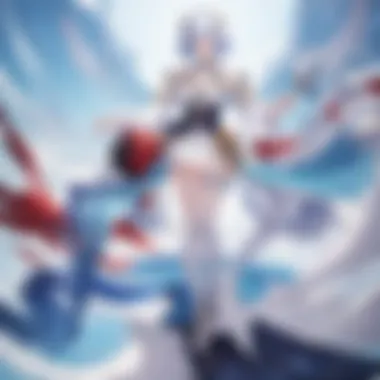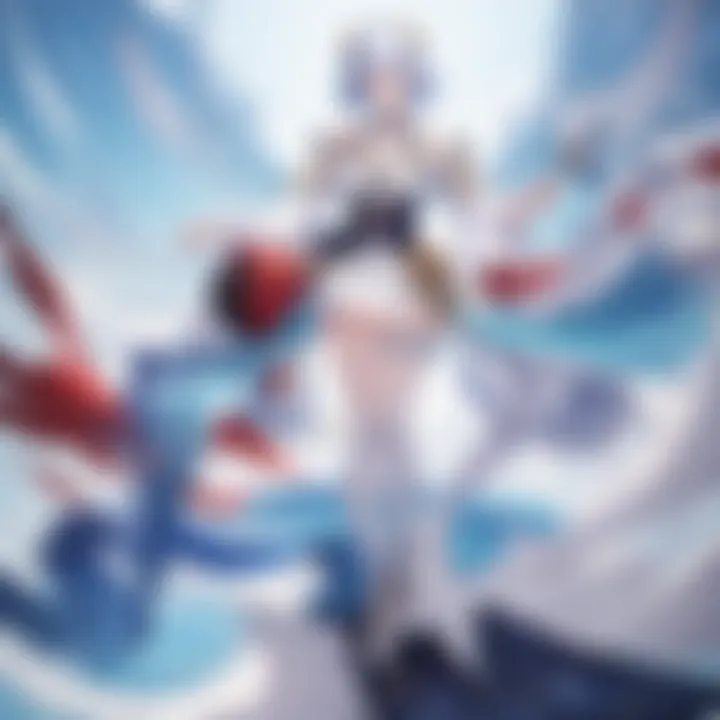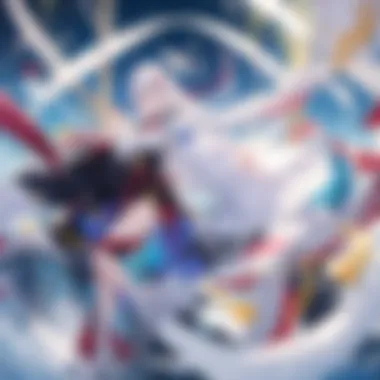Exploring Manhwa: Its Transformation into Video


Intro
The convergence of manhwa and video media offers a complex tapestry rich in cultural narratives and artistic innovation. When manhwa, a Korean form of comic, transitions to video formats such as animation and live-action adaptations, it does not merely replicate its source material. Instead, this process creates a new avenue for storytelling, dynamic visual representation, and character development that resonates with a broader audience. In this exploration, we will navigate the intricate pathways that connect these two realms, examining how they have evolved over time and why they hold significant cultural weight.
Character Profiles
Overview of Main Characters
At the heart of any compelling manhwa adaptation lies its characters. These characters often embody universal traits that resonate with viewers, which enhances depth and relatability. Someone like Jinwoo from "Solo Leveling" exemplifies this idea. His journey from a weak hunter to a powerful warrior captivates audiences due to themes of resilience and self-discovery.
Similarly, in "Tower of God", characters like Bam engage viewers with their complex backgrounds and motivations. They are not just vessels for plot progression; they reflect the intricacies of human emotion and moral ambiguity.
Supporting Characters
Supporting characters in manhwa adaptations play a crucial role as well. They enrich the storyline by providing dimensionality and context to the protagonist's journey. Characters like Rachel in "Tower of God" illustrate how relationships can drive the narrative forward, often complicating the hero's motivations. Moreover, side characters frequently offer comic relief, wisdom, or obstacles that make the hero's journey more compelling. Their interactions often highlight themes of friendship, betrayal, and sacrifice, serving as mirrors to the main characters' arcs.
Theme Exploration
Central Themes
Themes in manhwa often reflect societal issues and personal struggles, mirroring the cultural environment in which they originate. Many manhwa narratives delve into the concepts of power, identity, and the concept of fate versus free will. For instance, "Noblesse" discusses the responsibilities that accompany power while addressing themes of friendship and loyalty. This multifaceted exploration informs its video adaptations, translating rich inner conflicts into animated emotions and dialogues.
Cultural References
Cultural references in manhwa provide an additional layer of significance. They often include elements of Korean folklore, history, and popular culture, enriching the narrative and connecting with viewers at a deeper level. For instance, elements from traditional Korean stories can often be found within modern narratives, offering a glimpse into the cultural psyche. Understanding these references helps audiences appreciate the nuances of the plot and character motivations.
Popular Series and Recommendations
Top Anime Series of the Year
As manhwa increasingly cross over into the anime realm, several titles stand out:
- Hell’s Paradise: A gripping tale about a group of assassins navigating their way through a dangerous island. The adaptation captures the horror and beauty of the original art style.
- The God of High School: This series showcases martial arts competitions against a backdrop of divine powers, exploding with vibrant animation that stays true to its manhwa roots.
Hidden Gems in Manga
Not all popular series find mainstream success, and many hidden gems deserve attention:
- A Good Day to be a Dog: An unconventional romantic comedy that plays with transformations and identity crises in a light-hearted manner.
- Killing Stalking: This psychological thriller delves deep into obsession and trauma, making it a thought-provoking read.
Adapting manhwa into video formats not only revives stories but also amplifies their cultural impact, welcoming a new audience that transcends geographical boundaries.
Intro to Manhwa as a Video Medium
Manhwa's transition from page to screen is a notable phenomenon that reflects changes in media consumption. The rise of manhwa as a video medium holds significance not just in terms of entertainment but also for the cultural narratives it conveys. This section will explore how manhwa adapts to video formats, examining the benefits and considerations of this evolution.
Definition of Manhwa
Manhwa is a style of comic or graphic novel originating from Korea, characterized by its distinct artistic style and storytelling techniques. Unlike traditional manga, which is typically read from right to left, manhwa is usually read from left to right. This stylistic choice is part of what sets it apart and presents an accessible entry point for global readers. Manhwa encompasses various genres and often features complex plots that blend drama, humor, and deep character exploration.
Historical Context of Manhwa
The history of manhwa is deeply interwoven with Korea’s cultural and social evolution. Emerging in the late 19th century, manhwa initially mirrored Western comics. It gradually developed its own identity following the Korean War, influenced by political shifts and societal changes. The growth in popularity of manhwa in the 20th century was facilitated by advances in technology and shifts in reading habits, leading to a broad audience base in Korea. Today's vibrant manhwa scene reflects both historical struggles and modern aspirations, establishing itself as an important cultural artifact.
Emergence of Manhwa Video Adaptations
The adaptation of manhwa into video format marks a significant trend in the 21st century. The increased demand for visual entertainment has led producers to explore manhwa's rich narratives and visuals. Originally, adaptations occurred through animated series or films, reflecting the original material while appealing to new audiences. Many successful adaptations have found a global audience on platforms like Netflix and Crunchyroll. These adaptations often leverage the unique storytelling qualities of manhwa to enhance viewer engagement.


Manhwa adaptations can resonate on different levels, introducing viewers to not only the stories but also the cultural context of Korea. This new media landscape invites fans of different backgrounds to appreciate the depth of manhwa narratives, enriching the understanding of a traditionally Asian art form.
"The evolution of manhwa into video is not merely a trend; it's an invitation to understand a culture through its narratives and visuals."
As these adaptations grow in popularity, understanding the video medium's implications on manhwa will provide deeper insights into how stories are told and experienced.
Understanding the Manhwa Video Format
The evolution of manhwa into video formats has created a unique medium that is distinct from traditional forms of storytelling. Understanding the manhwa video format is crucial for appreciating how narratives adapt and expand their reach. This section will address key differentiations, innovative presentations, and the technical aspects that contribute to the creation of manhwa videos.
Differences Between Manhwa and Traditional Manga
At the core, manhwa and manga share similarities, as both arise from Asian comic traditions. However, there are many differences. Manhwa typically originates from South Korea, while manga comes from Japan. The stylistic approach also diverges. Manhwa often features colored illustrations, providing them a more vibrant appearance compared to traditional black-and-white manga.
Content pacing also contrasts. Manhwa tends to enable slower narrative development, allowing for deeper character exploration over time. Characters may be drawn with more modern influences, reflecting contemporary issues within South Korean society.
Here are some notable differences:
- Art Style: Manhwa often uses color, while manga is traditionally black and white.
- Read Direction: Manhwa is read left-to-right, contrasting manga's right-to-left dialogue.
- Cultural Context: The themes resonate with Korean culture and recent societal changes.
Innovations in Video Presentation
Video adaptations of manhwa have opened the door to various innovative presentation techniques. Creators now implement technology that enriches storytelling beyond what traditional print can achieve. For example, animated sequences and dynamic voice acting breathe life into characters, making their emotions palpable to the audience.
Moreover, the use of sound effects and music enhances the viewing experience. These elements create a more immersive atmosphere that encapsulates the viewer. Streaming platforms like Crunchyroll and Netflix have popularized these adaptations, showcasing the potential of newer formats.
Visually, some adaptations employ techniques that blend animations with static visuals. This hybrid approach gives viewers a unique flavor not found in either manga or traditional anime. The result is a narrative that captures the essence of the original manhwa while employing modern storytelling elements suitable for the digital age.
Technical Aspects of Manhwa Video Creation
The technical side of creating manhwa videos is intricate and demands collaboration among various experts. Animation artists, voice actors, and writers work together to translate static images into lively scenes. Here are some key components of the production process:
- Script Development: This process involves transforming the manhwa storyline into a suitable script for video format.
- Storyboarding: Visualizing each scene through detailed storyboards ensures that scenes maintain narrative cohesion.
- Animation Techniques: Different methods, from 2D animation to computer-generated imagery (CGI), are utilized to enhance visual appeal.
- Voice Acting: A critical aspect that adds depth, characters gain personality through skilled voice performances.
- Editing and Post-Production: Final touches come together in editing, where sound design and visual effects enhance the overall quality.
The combination of these technical aspects allows creators to realize their vision while staying true to the source material.
In summary, understanding the manhwa video format involves a deeper exploration of these distinctions, innovations, and technical elements that redefine storytelling for a modern audience. Each of these facets contributes to a richer understanding of manhwa's cultural resonance in today's digital landscape.
Cultural Impact of Manhwa Videos
The exploration of manhwa videos within popular culture reveals significant facets that shape and reflect societal values, trends, and issues. As these adaptations gain popularity, they profoundly affect Korean pop culture, influencing not only the narrative styles and themes presented but also extending their reach globally. This section will delve into three critical areas: the influence on Korean pop culture, the challenges of globalization and localization, and the dynamics of audience reception and engagement. Understanding these components helps illuminate the broader impact of manhwa videos in contemporary society.
Influence on Korean Pop Culture
Manhwa videos are integral to the fabric of Korean pop culture. With their unique storytelling and visual styles, these adaptations contribute to the rise of the Korean Wave, or Hallyu. This phenomenon encompasses the global spread of Korean culture, especially in the forms of music, drama, and, importantly, animation and visual storytelling.
- Visual Aesthetics: Manhwa videos often incorporate distinctive visual elements that set them apart from other animation styles, creating a unique viewer experience.
- Cultural Themes: These adaptations frequently address cultural narratives, capturing local societal issues that resonate with viewers, both domestic and international.
- Engagement with Fans: Collectively, these factors have led to a growing interest in manhwa and its video adaptations, fostering a dedicated fanbase that engages with the content through fandoms, online discussions, and merchandise.
Globalization and Localization Challenges
While manhwa videos have found a global audience, their journey to international markets is fraught with challenges. The nuances of cultural specificity can complicate the translation and adaptation process, raising significant concerns regarding authenticity and representation.
- Translation Barriers: Language differences often lead to lost meanings or cultural references that do not translate well, hindering viewer comprehension.
- Cultural Sensitivity: Localization must navigate the cultural norms and expectations of diverse global audiences, which can lead to significant changes in narrative content.
- Market Demand: Understanding regional preferences becomes essential in targeting content effectively. This requires intricate knowledge of local trends and viewer expectations.
Audience Reception and Engagement
The reception of manhwa videos varies across different audiences, highlighting the diverse ways in which people engage with the medium. Analyzing viewer interactions provides insight into the effectiveness of storytelling and the adaptation process.


- Viewer Preferences: Fans often have specific tastes, influencing which titles perform well in markets. Genres such as romance, horror, and fantasy have distinct followings, shaping production trends.
- Community Discussions: Platforms like Reddit and various social media channels facilitate discussions among fans, creating spaces for sharing interpretations, fan theories, and critiques.
- Impact of Reviews and Ratings: Critical acclaim can drive viewership. A strong review in major publications or influencer endorsements often leads to heightened interest and engagement with manhwa videos.
In essence, manhwa videos do not merely provide entertainment; they serve as a medium for cultural exchange, reflecting and shaping the values and experiences of diverse audiences around the world.
Understanding the cultural impact of manhwa videos allows for a more profound appreciation of their role within the larger scope of media and society. As this genre continues to evolve, its influence on community identity, global relations, and cultural trends will undoubtedly lead to new developments and changes.
Key Themes Explored in Manhwa Videos
The thematic depth within manhwa videos contributes significantly to their appeal and resonance among viewers. Exploring identity, addressing social issues, and presenting romantic narratives are common focal points. These themes reflect both individual experiences and broader societal contexts. They encourage viewers to connect on personal levels while also fostering discussions about complex, often underrepresented subjects. The exploration of these themes is critical, informing how stories are crafted and the messages they aim to deliver to audiences.
Exploring Identity and Individuality
One of the most prominent themes in manhwa videos is the exploration of identity and individuality. Characters frequently grapple with self-discovery, showcasing their journeys through various challenges. This theme resonates deeply with viewers, often inspiring introspection about their own identities. In a globalized world, many young adults find themselves confronting societal expectations versus personal desires. Manhwa video narratives excel at depicting these internal conflicts, offering relatable portrayals that viewers can connect with.
Additionally, the art style, characters’ design, and world-building elements further amplify these themes. Unique designs can symbolize deeper traits, enhancing the narrative's emotional impact. Audiences often find themselves reflecting on their own journeys and aspirations as they witness characters navigate their challenges. This focus on identity not only adds depth to the story but also encourages a broader dialogue about various cultural and social dynamics.
Social Issues and Commentary
Manhwa videos also present an avenue for social commentary, tackling pressing issues such as mental health, discrimination, and societal pressures. Such topics are addressed through character experiences, allowing for nuanced representations that invite conversation. By engaging in storytelling that reflects real-world complexities, manhwa videos challenge viewers to think critically about their environments.
For example, some narratives delve into the stigma surrounding mental health. By portraying characters facing such challenges, manhwa videos break down barriers of silence and ignorance associated with mental Illness. They provide a platform for understanding and empathy, promoting discussions that transcend personal experiences into wider societal discourse.
Moreover, the international reach of manhwa videos enables these themes to resonate across cultures, fostering a global dialogue. Elements from Korean culture may be blended with universal themes, providing a well-rounded perspective that both local and international viewers can appreciate. This intricate balance enriches the consumption experience.
Romance and Relationships
Romantic relationships in manhwa videos often serve as a canvas for deeper themes of connection and emotional intimacy. These narratives explore various facets of love, from first crushes to complex adult relationships. Manhwa videos frequently challenge traditional relationship tropes, offering fresh perspectives on romance.
The portrayal of relationships highlights important aspects such as communication, consent, and emotional vulnerability. Viewers witness characters navigate their feelings and confront obstacles, reinforcing the idea that love involves continual growth and understanding. This intricate web of relationships provides both entertainment and education, urging audiences to reflect on their own experiences within romantic contexts.
Furthermore, romance in manhwa videos often intertwines with other themes, such as identity struggles or societal critiques. These intertwining narratives create layers that engage viewers on multiple levels. They allow for an authentic examination of how love can be influenced by external circumstances as well as internal battles.
The Role of Technology in Manhwa Videos
Technology plays a pivotal role in the realm of manhwa videos, impacting production, distribution, and viewer engagement. As the industry evolves, the integration of advanced technology enables creators to explore new storytelling techniques and forms of expression. This section examines the various technological elements that influence manhwa videos, focusing on animation techniques, the significance of streaming platforms, and anticipations for future trends. Understanding these technological advancements is necessary for grasping the full significance of manhwa video adaptations.
Animation Techniques in Manhwa Videos
Animation in manhwa videos varies greatly from traditional forms. The visual style of manhwa, often characterized by detailed line work and distinct character designs, poses unique challenges for animators. Emerging animation techniques, such as 2D animations adapted from comic panels, enhance the visual storytelling. Some notable techniques include:
- Motion Capture: This technology captures real actor movements to create more fluid animations.
- Digital In-betweening: A process that fills in frames between key drawings, enhancing animation smoothness.
- Hybrid 2D/3D Techniques: Utilizing 3D elements along with traditional 2D styles creates depth and complexity.
These techniques not only preserve the original aesthetic of manhwa but also make narratives more dynamic and immersive.
Impact of Streaming Platforms
The rise of streaming platforms like Netflix and Crunchyroll significantly reshapes the distribution and accessibility of manhwa videos. These platforms allow immediate access to content from anywhere in the world. Their breadth of services facilitates a global audience that appreciates diverse narratives. The benefits include:
- Wider Audience Reach: Streaming services bridge cultural gaps, making manhwa accessible to international viewers, thus broadening its fanbase.
- Monetization Opportunities: Creators benefit from subscription models, enabling more projects to come to life due to financial backing.
- Interactive Features: Some platforms allow for viewer feedback, influencing future adaptations and series direction.
The convenience of streaming platforms situates them as critical players in the evolution of manhwa videos, shaping audience expectations and industry standards.
Future Innovations and Trends
As technology continues to advance, the manhwa video genre is poised for further growth. Potential trends include:
- Virtual Reality (VR): This could offer viewers an immersive experience that engages them directly within the story.
- Artificial Intelligence (AI): AI could streamline animation processes and personalize viewer experiences based on individual preferences.
- Augmented Reality (AR): AR might enable interactive viewing experiences, allowing audiences to explore manhwa worlds in innovative ways.


Future innovations will likely enhance narrative complexity and viewer engagement, ensuring that manhwa videos remain relevant and compelling. The path forward in manhwa videos is bright, shaped by the technological developments that continue to emerge.
Popular Manhwa Video Series and Films
The world of manhwa extends far beyond the pages of printed comics. Its translations into video form have become a significant aspect of its popularity and cultural impact. This section delves into notable manhwa adaptations, highlighting their significance in shaping the genre and engaging audiences on a larger scale. The fusion of storytelling, artwork, and sound in these adaptations allows for a multidimensional experience that captivates viewers, ultimately contributing to the ongoing global rise of manhwa.
Trendsetting Titles in the Genre
The exploration of popular manhwa video series begins with key titles that have made a mark in the industry. Series such as "Tower of God" and "The God of High School" have become exceptionally influential. Each boasts distinct storytelling techniques and visually stunning animation that resonate with audiences. These adaptations often diverge from their original manhwa frameworks to incorporate more nuanced narrative elements, thus appealing to both existing fans and newcomers.
Notably, "Solo Leveling" represents another pivotal title. Its gripping plot and dynamic action sequences attract viewership, showcasing the potential manhwa holds in captivating wide audience.
Critical Acclaim and Awards
Critical acclaim plays a crucial role in establishing the value of manhwa video adaptations. Several series have received prestigious awards, highlighting their artistic and narrative merits. For example, "The God of High School" was nominated for awards that honor excellence in animation, demonstrating how video adaptations can enhance the original storylines.
Such recognition influences audience perception and contributes to the genre's growth, as viewers are often drawn to content that has garnered acclaim. The awards also serve as benchmarks, prompting creators to elevate their storytelling and artistic techniques in future projects.
Viewer Favorites and Community Discussions
Viewer reception is a crucial aspect in the success of manhwa video adaptations. Communities formed around series like "Noblesse" generate rich discussions and fan engagements on platforms such as Reddit and Facebook. Viewers express their thoughts on plot developments, character arcs, and artistic approaches. Such exchanges foster a deeper connection with the material and its creators.
In many cases, viewers become vocal advocates for their favorite series, helping to sustain interest and generate buzz for upcoming episodes. Highlights from community discussions often note character development, pacing, and fidelity to source materials. This creates a lively atmosphere that encourages ongoing dialogue about the future direction of manhwa adaptations.
In summary, the examination of popular manhwa video series and films reveals their significance in establishing the genre's relevance. With trendsetting titles capturing the imagination, critical acclaim validating their artistic contributions, and dedicated communities fostering meaningful conversations, these adaptations shape the understanding and appreciation of manhwa in the video realm.
The Future of Manhwa Video Adaptations
The future of manhwa video adaptations appears promising, as cultural phenomena increasingly shape entertainment consumption worldwide. This section addresses anticipated adaptations, shifts in audience preferences, and sustainability crucial for the genre's growth throughout the global market.
Anticipated Adaptations and Releases
Several manhwa titles gain traction, presenting exciting potential for adaptation into video formats. Notably, works like "Tower of God" and "The God of High School" have already made their mark, resulting in successful series. As these adaptations generate interest, other titles such as "Solo Leveling" and "Noblesse" are on the radar for upcoming releases. These adaptations aim to capitalize on original storytelling, unique art styles, and engaging characters.
Content creators are keen to tap into the strengths of manhwa, utilizing animation techniques and storytelling dynamics that align with global trends. The move towards both animated series and live-action films becomes more significant in a world where visual media prevails.
Shifts in Audience Preferences
Recent years show a shift in audience preferences that influences the direction of manhwa adaptations. Several factors contribute to this transformation. Viewers now gravitate towards diverse genres, appreciating complex narratives that go beyond traditional tropes. This demands that creators incorporate rich storytelling elements into adaptations.
Additionally, the prominence of streaming platforms like Netflix and Crunchyroll fosters a global audience. They allow access to a broader array of titles beyond Japan's manga. Audiences increasingly seek content with varied cultural backgrounds, allowing manhwa to flourish beyond its Korean roots.
Sustainability of the Genre
The sustainability of manhwa video adaptations depends on various factors. To maintain relevance, the industry must ensure consistent quality in storytelling and production. If adaptations deviate from the essence of their source material, audience backlash may compromise future projects.
Economic viability plays a role too. Successful manhwa adaptations can attract investments, fuelling further developments in the industry. Partnerships with established animation studios and experienced creators will help solidify the genre's future.
Overall, the future of manhwa video adaptations hinges on the interplay of programming choices, audience habits, and market dynamics, offering a landscape full of potential and innovation.
Culmination
In this final section, we will explore the importance of manhwa video adaptations within the broader context of both the medium and its audience. The fusion of manhwa and video not only highlights the evolving landscape of entertainment but also emphasizes how cultural narratives are reshaped for contemporary viewers. These adaptations serve as a bridge, connecting fans to the rich story worlds found in manhwa, while also introducing new audiences to this unique form of expression.
Summary of Key Insights
Manhwa videos bring forth distinctive characteristics that set them apart from traditional animated practices. Here are several key insights:
- Narrative Depth: Many manhwa adaptations maintain the complex narrative structures found in their source material, allowing for detailed character development and nuanced storytelling.
- Visual Innovations: The animation techniques employed often reflect the original artistic styles of the manhwa, creating a sense of authenticity. This visual fidelity is crucial for fans who appreciate the illustration styles that manhwa offers.
- Cultural Relevance: The themes explored in manhwa videos often resonate with societal issues prevalent in both Korean culture and globally. This fosters a connection with viewers who identify with the stories and characters.
- Audience Engagement: The transition from print to screen creates opportunities for engagement through social media platforms, fostering discussions and communities around shared interests.
Final Thoughts on Manhwa and Video
As manhwa continues to expand into the video realm, the implications are significant. The adaptations not only strengthen the cultural presence of manhwa but also introduce a global audience to Korean stories and artistry. Importantly, the balance between staying true to the source material and exploring new storytelling methods in video form is critical.
"The success of manhwa video adaptations lies in their ability to resonate culturally while pushing the boundaries of artistic expression."







